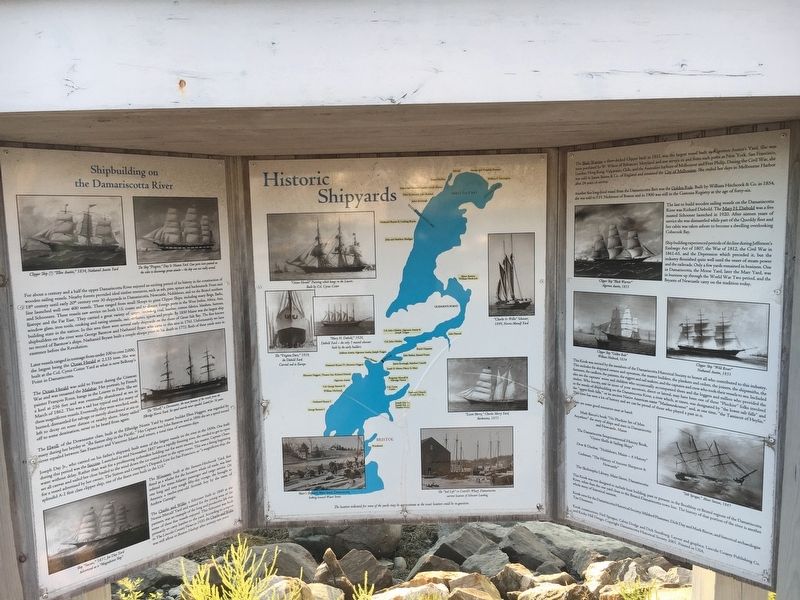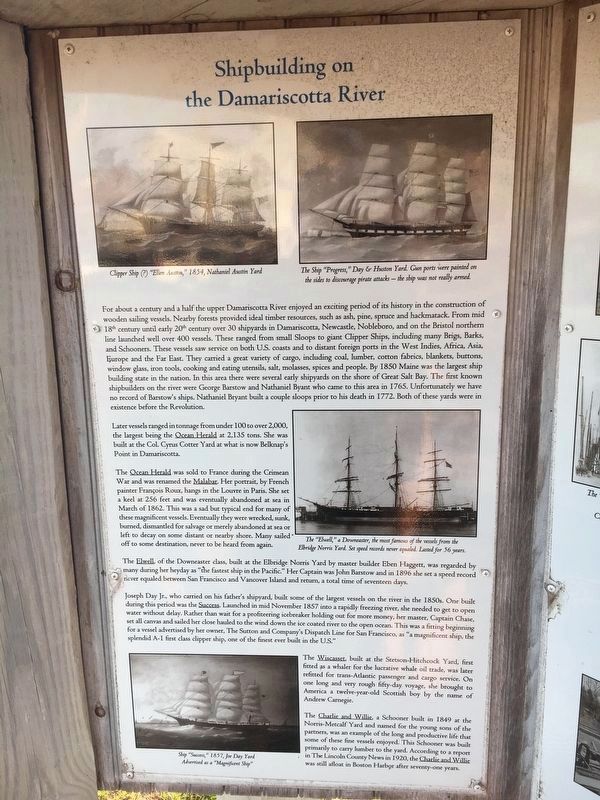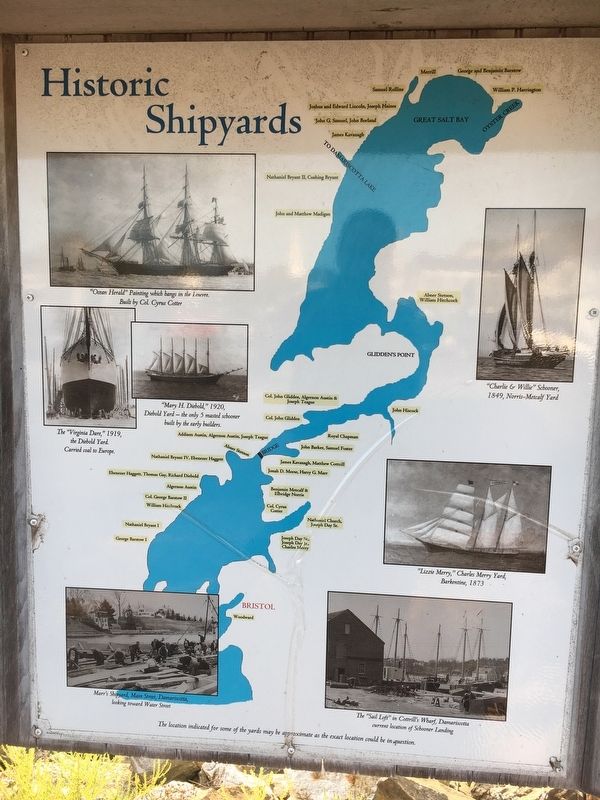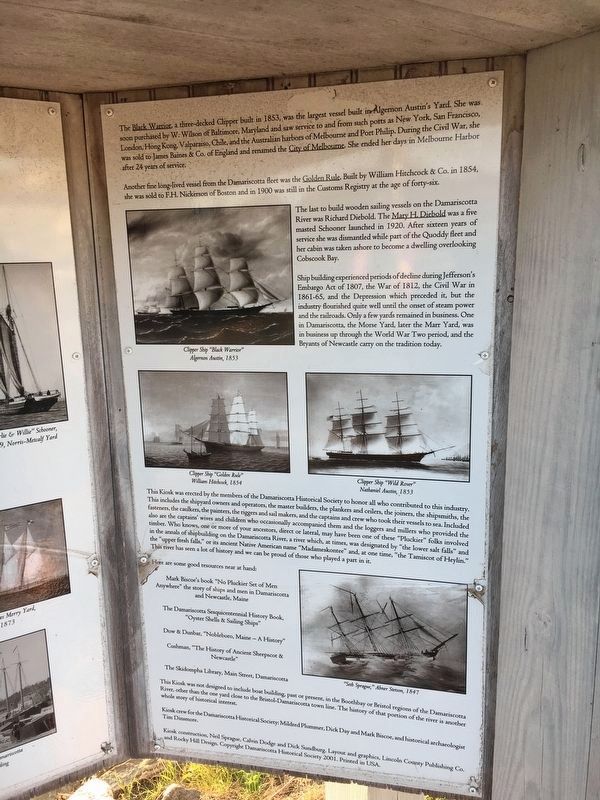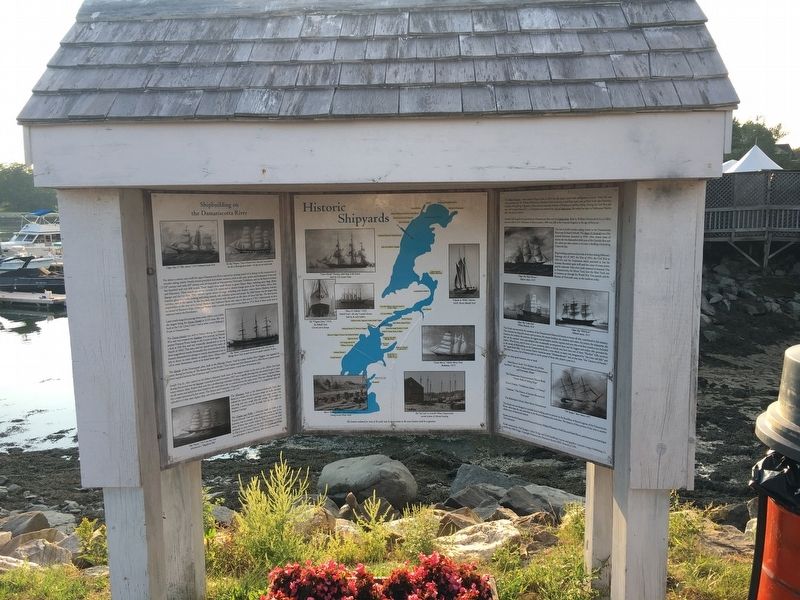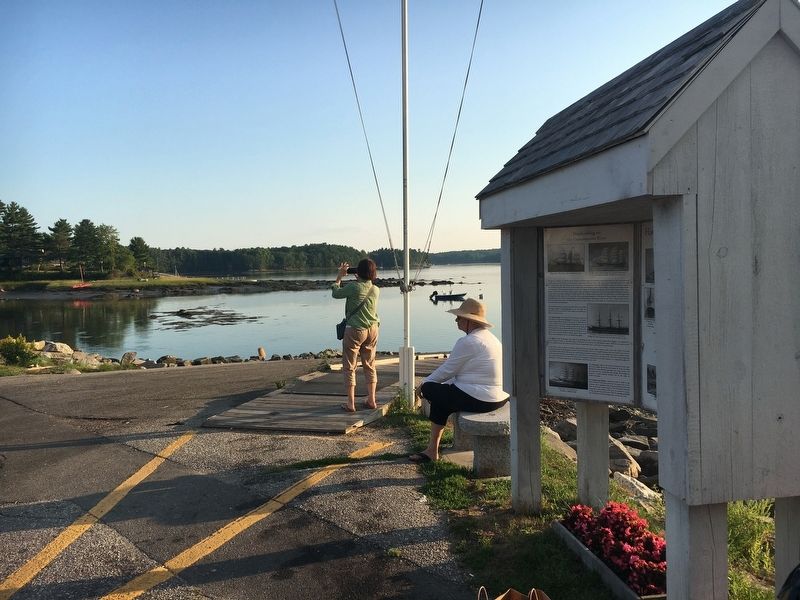Damariscotta in Lincoln County, Maine — The American Northeast (New England)
Shipbuilding on the Damariscotta River
( left panel )
For about a century and a half the upper Damariscotta River enjoyed an exciting period of its history in the construction of wooden sailing vessels. Nearby forests provided ideal timber resources, such as ash, pine, spruce and hackmatack. From mid 18th century until early 20th century over 30 shipyards in Damariscotta, Newcastle, Nobleboro, and on the Bristol northern line launched well over 400 vessels. These ranged from small Sloops to giant Clipper Ships, including many Brigs, Barks, and Schooners. These vessels saw service on both US coasts and to distant foreign ports in the West Indies, Africa, Asia, Europe and the Far East. They carried a great variety of cargo, including coal, lumber, cotton fabrics, blankets, buttons, window glass, iron tools, cooking and eating utensils, salt, molasses, spices and people. By 1850 Maine was the largest ship building state in the nation. In this area there were several early shipyards on the shore of Great Salt Bay. The first known shipbuilders on the river were George Barstow and Nathaniel Byant who came to this area in 1765. Unfortunately we have no record of Barstow's ships. Nathaniel Bryant built a couple sloops prior to his death in 1772. Both of these yards were in existence before the Revolution.
Later vessels ranged in tonnage from under 100 to over 2,000, the largest being the Ocean Herald at 2,135 tons. She was built at the Col. Cyrus Cotter Yard at what is now Belknap's Point in Damariscotta.
The Ocean Herald was sold to France during the Crimean War and was renamed the Malabar. Her portrait, by French painter François Roux, hangs in the Louvre in Paris. She set a keel at 256 feet and was eventually abandoned at sea in March of 1862. This was a sad but typical end for many of these magnificent vessels. Eventually they were wrecked, sunk, burned, dismantled for salvage or merely abandoned at sea or left to decay on some distant or nearby shore. Many sailed" off to some destination, never to be heard from again.
The Ellwell of the Downeaster class, built at the Elbridge Norris Yard by master builder Eben Haggett, was regarded by many during her heyday as "the fastest ship in the Pacific.” Her Captain was John Barstow and in 1896 she set a speed record never equaled between San Francisco and Vancover Island and return, a total time of seventeen days.
Joseph Day Jr, who carried on his father's shipyard, built some of the largest vessels on the river in the 1850s. One built during this period was the Success. Launched in mid November 1857 into a rapidly freezing river, she needed to get to open water without delay. Rather than wait for a profiteering icebreaker holding out for more money, her master, Captain Chase, set all canvas and sailed her close hauled to the wind down the ice coated river to the open ocean. This was a fitting beginning for a vessel advertised by her owner, The Sutton and Company's Dispatch Line for San Francisco, as "a magnificent ship, the splendid A-I first class clipper ship, one of the finest ever built in the US."
The Wiscasset, built at the Stetson-Hitchcock Yard, first fitted as a whaler for the lucrative whale oil trade, was later refitted for trans-Atlantic passenger and cargo service. On one long and very rough fifty-day voyage, she brought to America a twelve-year-old Scottish boy by the name of Andrew Carnegie.
The Charlie and Willie, a Schooner built in 1849 at the Noris-Metcalf Yard and named for the young sons of the partners, was an example of the long and productive life that some of these fine vessels enjoyed. This Schooner was built primarily to carry lumber to the yard. According to a report in The Lincoln County News in 1920, the Charlie and Willie was still afloat in Boston Harbor after seventy-one years.
( photo captions )
— Clipper Ship (?) “Ellen Austin,” 1854, Nathanial Austin Yard
— The Ship “Progress,” Day & Hudson Yard. Gun ports were painted on the sides to discourage pirate attacks -- the ship was not really armed.
— The “Elwell,” a Downeaster, the most famous of the vessels from Elbridge Norris Yard. Set speed records never equaled. Lasted for 56 years.
— Ship “Success,” 1857, Joe Day Yard. Advertised as a “Magnificent Ship.”
( middle panel )
( photo captions )
— “Ocean Herald” Painting which hangs in the Louvre. Built by Col. Cyrus Cotter.
— The “Virgian Dare,” 1919, the Diebold Yard. Carried coal to Europe.
— “Mary H. Diebold,” 1920, Diebold Yard -- the only 5 masted schooner built by the early builders.
— “Charlie & Willie” Schooner, 1849, Norris-Metcalf Yard.
— “Lizzie Merrie,” Charles Merry Yard, Barkentine, 1873.
— Marr's Shipyard, Main Street, Damariscotta, looking toward the water.
— The “Sail Loft” in Cottrill's Wharf, Damariscotta, current location of schooner landing.
( right panel )
The Black Warrior, a three-decked Clipper built in 1853, was the largest vessel built in Algemon Austin's Yard. She was soon parchased by W. Wilson of Baltimore, Maryland and saw service to and from such ports as New York, San Francisco, London Hong Kong Valparaiso, Chile, and the Australian harbors of Melbourne and Port Philip. During the Civil War, she was sold to James Baines & Co. of England and renamed the City of Melborne. She ended her days in Melbourne Harbor after 24 years of service.
Another fine long-lived vessel from the Damariscotta fleet was the Golden Rule. Built by William Hitchcock & Co. in 1854, she was sold to FH. Nickinson of Boston and in 1900 was still in the Customs Registry at the age of forty-six.
The last to build wooden sailing vessels on the Damariscotta River was Richard Diebold. The Mary H. Diebold was a five masted Schooner launched in 1920. After sixteen years of service she was dismantled while part of the Quoddy fleet and her cabin was taken ashore to become a dwelling overlooking Cobecook Bay.
Shipbuilding experienced periods of decline during Jefferson's Embargo Act of 1807, the War of 1812, the Civil War in 1861-65, and the Depression which preceded it, but the industry flourished quite well until the onset of steam power and the railroads. Only a few yards remained in business. One in Damariscotta, the Morse Yard, later the Marr Yard, was in business up through the World War Two period, and the Bryants of Newcastle carry on the tradition today.
This Kiosk was erected by the members of the Damariscotta Historical Society to honor all who contributed to this industry. This includes the shipyard owns and operators, the master builders, the plankers and oilers, the joiners, the shipsmiths, the fasteners, the caulkers.the painters, the riggers and sail makers, and the captains and crew who took their vessels to sea. Included also are the captains’ wives and children who occasionally accompanied them and the loggers and millers who provided the timber. Who knows, one or more of your ancestors, direct or lateral, may have been one of these "Plockier" folks involved in the annals of shipbuilding on the Damariscotta River, which, at times, was designated by "the lower salt falls" and the "upper fresh falls” or its ancient Native American name "Madameskoe" and, at one time, "the Tamiscot of Heylin.” This river has seen a lot of history and we can be proud of those who played a part in it.
( photo captions )
— Clipper Ship “Black Warrior” Algernon Austin, 1853
— Clipper Ship “Golden Rule” William Hedeck, 1854
— Clipper Ship “Wild Rose” Nathaniel Austin, 1853
— “Seth Sprague” Abner Swain, 1847
Erected by Damariscotta Historical Society.
Topics. This historical marker is listed in these topic lists: Industry & Commerce • Waterways & Vessels.
Location. 44° 1.961′ N, 69° 31.986′ W. Marker is in Damariscotta, Maine, in Lincoln County. Marker can be reached from Main Street (U.S. 1) east of Water Street, on the right when traveling west. Located in the parking lot next to the Damariscotta Town Landing. Touch for map. Marker is at or near this postal address: 49 Main Street, Damariscotta ME 04543, United States of America. Touch for directions.
Other nearby markers. At least 8 other markers are within 14 miles of this marker, measured as the crow flies. R.H.T. Taylor Store in 1882 (approx. 6.9 miles away); Downtown Stores c. 1892 (approx. 6.9 miles away); Wawenock Block • 1858 (approx. 6.9 miles away); Nickels-Sortwell House 1807 (approx. 6.9 miles away); Hilton House, 1892 & Sunken Garden, 1904 (approx. 6.9 miles away); Boothbay Maine Civil War Monument (approx. 11.9 miles away); In Grateful Memory of Ensign Richard Rundlett Wells (approx. 13 miles away); Ralph Blaisdell and Family (approx. 13.6 miles away).
Credits. This page was last revised on September 11, 2022. It was originally submitted on August 30, 2022, by D Howitt of Bergen County, New Jersey. This page has been viewed 339 times since then and 91 times this year. Photos: 1, 2, 3, 4, 5, 6. submitted on August 30, 2022, by D Howitt of Bergen County, New Jersey. • Michael Herrick was the editor who published this page.
